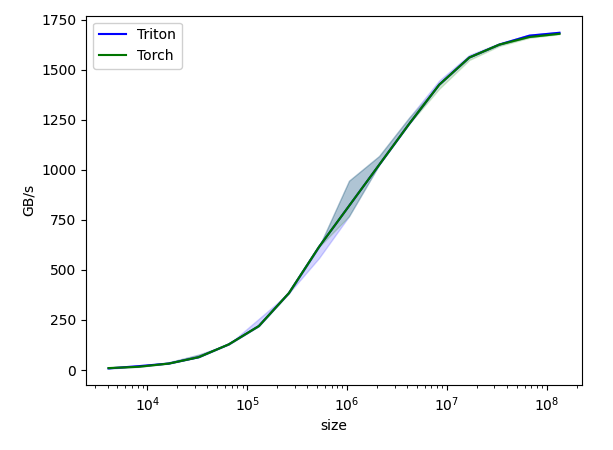向量相加
在本教程中,你将使用 Triton 编写一个简单的向量相加 (vector addition) 程序。
你将了解:
- Triton 的基本编程模型
- 用于定义 Triton 内核的
triton.jit装饰器 (decorator) - 验证和基准测试自定义算子与原生参考实现的最佳实践
计算内核
import torch
import triton
import triton.language as tl
@triton.jit
def add_kernel(x_ptr, # *Pointer* to first input vector. 指向第一个输入向量的指针。
y_ptr, # *Pointer* to second input vector. 指向第二个输入向量的指针。
output_ptr, # *Pointer* to output vector. 指向输出向量的指针。
n_elements, # Size of the vector. 向量的大小。
BLOCK_SIZE: tl.constexpr, # Number of elements each program should process. 每个程序应处理的元素数量。
# NOTE: `constexpr` so it can be used as a shape value. 注意:`constexpr` 因此它可以用作形状值。
):
# There are multiple 'programs' processing different data. We identify which program
# 有多个“程序”处理不同的数据。需要确定是哪一个程序:
pid = tl.program_id(axis=0) # We use a 1D launch grid so axis is 0. 使用 1D 启动网格,因此轴为 0。
# This program will process inputs that are offset from the initial data.
# 该程序将处理相对初始数据偏移的输入。
# For instance, if you had a vector of length 256 and block_size of 64, the programs would each access the elements [0:64, 64:128, 128:192, 192:256].
# 例如,如果有一个长度为 256, 块大小为 64 的向量,程序将各自访问 [0:64, 64:128, 128:192, 192:256] 的元素。
# Note that offsets is a list of pointers:
# 注意 offsets 是指针列表:
block_start = pid * BLOCK_SIZE
offsets = block_start + tl.arange(0, BLOCK_SIZE)
# Create a mask to guard memory operations against out-of-bounds accesses.
# 创建掩码以防止内存操作超出边界访问。
mask = offsets < n_elements
# Load x and y from DRAM, masking out any extra elements in case the input is not a multiple of the block size.
# 从 DRAM 加载 x 和 y,如果输入不是块大小的整数倍,则屏蔽掉任何多余的元素。
x = tl.load(x_ptr + offsets, mask=mask)
y = tl.load(y_ptr + offsets, mask=mask)
output = x + y
# Write x + y back to DRAM.
# 将 x + y 写回 DRAM。
tl.store(output_ptr + offsets, output, mask=mask)
创建一个辅助函数从而: (1) 生成 z 张量,(2) 用适当的 grid/block sizes 将上述内核加入队列:
def add(x: torch.Tensor, y: torch.Tensor):
# We need to preallocate the output.
# 需要预分配输出。
output = torch.empty_like(x)
assert x.is_cuda and y.is_cuda and output.is_cuda
n_elements = output.numel()
# The SPMD launch grid denotes the number of kernel instances that run in parallel.
# SPMD 启动网格表示并行运行的内核实例的数量。
# It is analogous to CUDA launch grids. It can be either Tuple[int], or Callable(metaparameters) -> Tuple[int].
# 它类似于 CUDA 启动网格。它可以是 Tuple[int],也可以是 Callable(metaparameters) -> Tuple[int]。
# In this case, we use a 1D grid where the size is the number of blocks:
# 在这种情况下,使用 1D 网格,其中大小是块的数量:
grid = lambda meta: (triton.cdiv(n_elements, meta['BLOCK_SIZE']), )
# NOTE:
# 注意:
# - Each torch.tensor object is implicitly converted into a pointer to its first element.
# - 每个 torch.tensor 对象都会隐式转换为其第一个元素的指针。
# - `triton.jit`'ed functions can be indexed with a launch grid to obtain a callable GPU kernel.
# - `triton.jit` 函数可以通过启动网格索引来获得可调用的 GPU 内核。
# - Don't forget to pass meta-parameters as keywords arguments.
# - 不要忘记以关键字参数传递元参数。
add_kernel[grid](x, y, output, n_elements, BLOCK_SIZE=1024)
# We return a handle to z but, since `torch.cuda.synchronize()` hasn't been called, the kernel is still running asynchronously at this point.
# 返回 z 的句柄,但由于 `torch.cuda.synchronize()` 尚未被调用,此时内核仍在异步运行。
return output
使用上述函数计算两个 torch.tensor 对象的 element-wise sum,并测试其正确性:
torch.manual_seed(0)
size = 98432
x = torch.rand(size, device='cuda')
y = torch.rand(size, device='cuda')
output_torch = x + y
output_triton = add(x, y)
print(output_torch)
print(output_triton)
print(f'The maximum difference between torch and triton is '
f'{torch.max(torch.abs(output_torch - output_triton))}')
Out:
tensor([1.3713, 1.3076, 0.4940, ..., 0.6724, 1.2141, 0.9733], device='cuda:0')
tensor([1.3713, 1.3076, 0.4940, ..., 0.6724, 1.2141, 0.9733], device='cuda:0')
The maximum difference between torch and triton is 0.0
现在准备就绪。
基准测试
在 size 持续增长的向量上对自定义算子进行基准测试,从而比较其与 PyTorch 的性能差异。为了方便操作,Triton 提供了一系列内置工具,允许开发者简洁地绘制自定义算子在不同问题规模 (problem sizes) 下的的性能图。
@triton.testing.perf_report(
triton.testing.Benchmark(
x_names=['size'], # Argument names to use as an x-axis for the plot. 用作绘图 x 轴的参数名称。
x_vals=[2**i for i in range(12, 28, 1)], # Different possible values for `x_name`. `x_name` 的不同可能值。
x_log=True, # x axis is logarithmic. x 轴为对数。
line_arg='provider', # Argument name whose value corresponds to a different line in the plot. 参数名称,其值对应于绘图中的不同线条。
line_vals=['triton', 'torch'], # Possible values for `line_arg`. `line_arg` 的可能值。
line_names=['Triton', 'Torch'], # Label name for the lines. 线条的标签名称。
styles=[('blue', '-'), ('green', '-')], # Line styles. 线条样式。
ylabel='GB/s', # Label name for the y-axis. y 轴标签名称。
plot_name='vector-add-performance', # Name for the plot. Used also as a file name for saving the plot. 绘图名称。也用作保存绘图的文件名。
args={}, # Values for function arguments not in `x_names` and `y_name`. 不在 `x_names` 和 `y_name` 中的函数参数值。
))
def benchmark(size, provider):
x = torch.rand(size, device='cuda', dtype=torch.float32)
y = torch.rand(size, device='cuda', dtype=torch.float32)
quantiles = [0.5, 0.2, 0.8]
if provider == 'torch':
ms, min_ms, max_ms = triton.testing.do_bench(lambda: x + y, quantiles=quantiles)
if provider == 'triton':
ms, min_ms, max_ms = triton.testing.do_bench(lambda: add(x, y), quantiles=quantiles)
gbps = lambda ms: 3 * x.numel() * x.element_size() / ms * 1e-6
return gbps(ms), gbps(max_ms), gbps(min_ms)
运行上述装饰函数 (decorated function)。输入 print_data=True 查看性能数据,输入 show_plots=True 绘制结果, 以及/或者输入 save_path='/path/to/results/' 将其与原始 CSV 数据一起保存到磁盘:
benchmark.run(print_data=True, show_plots=True)

Out:
| size | Triton | Torch |
|---|---|---|
| 4096.0 | 8.000000 | 9.600000 |
| 8192.0 | 19.200000 | 15.999999 |
| 16384.0 | 31.999999 | 31.999999 |
| 32768.0 | 63.999998 | 63.999998 |
| 65536.0 | 127.999995 | 127.999995 |
| 131072.0 | 219.428568 | 219.428568 |
| 262144.0 | 384.000001 | 384.000001 |
| 524288.0 | 614.400016 | 614.400016 |
| 1048576.0 | 819.200021 | 819.200021 |
| 2097152.0 | 1023.999964 | 1023.999964 |
| 4194304.0 | 1228.800031 | 1228.800031 |
| 8388608.0 | 1424.695621 | 1424.695621 |
| 16777216.0 | 1560.380965 | 1560.380965 |
| 33554432.0 | 1624.859540 | 1624.859540 |
| 67108864.0 | 1669.706983 | 1662.646960 |
| 134217728.0 | 1684.008546 | 1678.616907 |
Download Jupyter notebook: 01-vector-add.ipynb